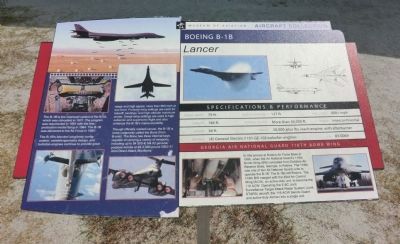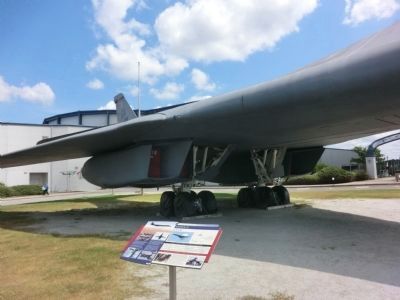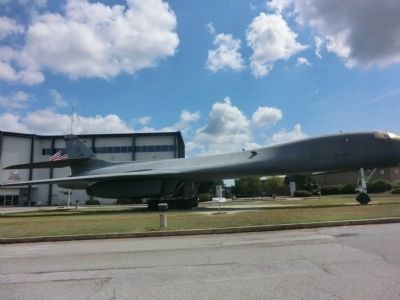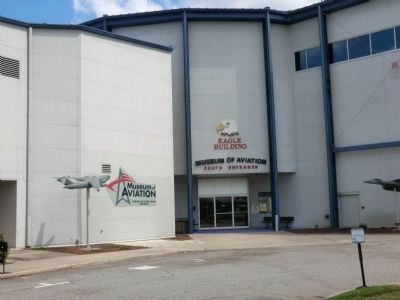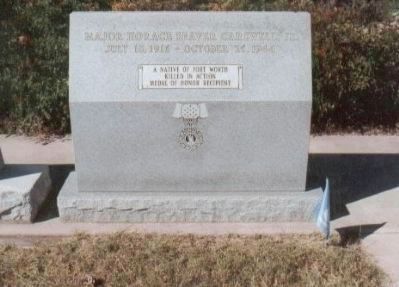Warner Robins in Houston County, Georgia — The American South (South Atlantic)
Boeing B-1B Lancer
Museum of Aviaton
— Aircraft Collection —
The B-1B’s blended wing/body configuration, variable-geometry design, and turbofan engines continue to provide great range and high speed, more than 900 mph at sea level. Forward wing settings are used for takeoff, landings, and high-altitude maximum cruise. Swept wing settings are used in high subsonic and supersonic flight and also enhance the B-1B’s maneuverability.
Though officially named Lancer, the B-B1B is more commonly called the Bone (from B-one). The Bone has three internal bays capable of carrying a variety of weapons, including up to 84 500-lb Mk 82 general-purpose bombs or 24 2,000-pound GBU-31 Joint Direct Attack Munitions.
Specifications & Performance
Wings Swept 79 ft.
Wings-forward 137 ft.
Max Speed 900+ mph
Length 146 ft.
Service Ceiling More than 30,000 ft.
Range Intercontinental
Height 34 ft.
Thrust 30,000-plus lbs./each engine, with afterburner
Engines (4) General Electric F101-GE-102 turbofan engines
S/N 83-0069
Georgia Air National Guard 116th Bomb Wing
B-1Bs arrived at Robins Air Force Base in 1996, when the Air National Guard's 116th Bomb Wing (BW) relocated from Dobbins AirReserve Base, Georgia, to Robins. The 116th was one of two Air National Guard units to operate the B-1B. The B-B1s left Robins. The 116th BW merged with the 93rd Air Control Wing (ACW), an active-duty unit, to become the 116 ACW. Operating the E-8C Joint Surveillance Target Attack Radar System (Joint STARS) aircraft, the 116 ACW blends Guard and active-duty Airmen into a single unit.
Erected by Museum of Aviaton.
Topics. This historical marker is listed in this topic list: Air & Space. A significant historical year for this entry is 1977.
Location. 32° 35.507′ N, 83° 35.302′ W. Marker is in Warner Robins, Georgia, in Houston County. Marker is on Heritage Boulevard, 0.1 miles east of Oak Avenue (U.S. 129), on the right when traveling north. The marker is located on the grounds of the Museum of Aviation at Robins Air Force Base. Touch for map. Marker is at or near this postal address: 1942 Heritage Blvd, Warner Robins GA 31098, United States of America. Touch for directions.
Other nearby markers. At least 8 other markers are within 3 miles of this marker, measured as the crow flies. The Medal of Honor (about 300 feet away, measured in a direct line); POW/MIA Memorial (about 300 feet away); 19th Air Refueling Wing Monument (about 300 feet away); The Jody Town Community (approx. one mile away); Warner Robins Depot (approx. 2.1 miles away); Caboose SOU X556 (approx. 2.1 miles away); "Butch" – University of Georgia's First Bulldog (approx. 2.1 miles away); Mildred's Country Store (approx. 2.1 miles away). Touch for a list and map of all markers in Warner Robins.
Also see . . . Mueum of Aviation, Robins AFB. A U.S. Air Force Museum - Home of the Georgia Aviation Hall of Fame (Submitted on November 13, 2013.)
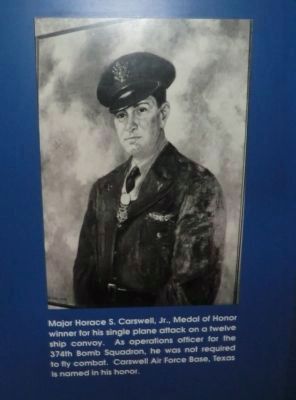
Photographed By Don Morfe, September 20, 2013
6. Horace Carswell Jr., Medal of Honor Recipient
(Portrait in the Museum of Aviation)
Medal of Honor Citation:
* CARSWELL, HORACE S., JR. (Air Mission)
• Rank and organization: Major, 308th Bombardment Group, U.S. Army Air Corps.
• Place and date: Over South China Sea, 26 October 1944
• Entered service at: San Angelo, Tex.
• G.O. No.: 14, 4 February 1946
Citation: He piloted a B-24 bomber in a one-plane strike against a Japanese convoy in the South China Sea on the night of 26 October 1944. Taking the enemy force of 12 ships escorted by at least 2 destroyers by surprise, he made 1 bombing run at 600 feet, scoring a near miss on 1 warship and escaping without drawing fire. He circled. and fully realizing that the convoy was thoroughly alerted and would meet his next attack with a barrage of antiaircraft fire, began a second low-level run which culminated in 2 direct hits on a large tanker. A hail of steel from Japanese guns, riddled the bomber, knocking out 2 engines, damaging a third, crippling the hydraulic system, puncturing 1 gasoline tank, ripping uncounted holes in the aircraft, and wounding the copilot; but by magnificent display of flying skill, Maj. Carswell controlled the plane's plunge toward the sea and carefully forced it into a halting climb in the direction of the China shore. On reaching land, where it would have been possible to abandon the staggering bomber, one of the crew discovered that his parachute had been ripped by flak and rendered useless; the pilot, hoping to cross mountainous terrain and reach a base. continued onward until the third engine failed. He ordered the crew to bail out while he struggled to maintain altitude. and, refusing to save himself, chose to remain with his comrade and attempt a crash landing. He died when the airplane struck a mountainside and burned. With consummate gallantry and intrepidity, Maj. Carswell gave his life in a supreme effort to save all members of his crew. His sacrifice. far beyond that required of him, was in keeping with the traditional bravery of America's war heroes.
Medal of Honor Citation:
* CARSWELL, HORACE S., JR. (Air Mission)
• Rank and organization: Major, 308th Bombardment Group, U.S. Army Air Corps.
• Place and date: Over South China Sea, 26 October 1944
• Entered service at: San Angelo, Tex.
• G.O. No.: 14, 4 February 1946
Citation: He piloted a B-24 bomber in a one-plane strike against a Japanese convoy in the South China Sea on the night of 26 October 1944. Taking the enemy force of 12 ships escorted by at least 2 destroyers by surprise, he made 1 bombing run at 600 feet, scoring a near miss on 1 warship and escaping without drawing fire. He circled. and fully realizing that the convoy was thoroughly alerted and would meet his next attack with a barrage of antiaircraft fire, began a second low-level run which culminated in 2 direct hits on a large tanker. A hail of steel from Japanese guns, riddled the bomber, knocking out 2 engines, damaging a third, crippling the hydraulic system, puncturing 1 gasoline tank, ripping uncounted holes in the aircraft, and wounding the copilot; but by magnificent display of flying skill, Maj. Carswell controlled the plane's plunge toward the sea and carefully forced it into a halting climb in the direction of the China shore. On reaching land, where it would have been possible to abandon the staggering bomber, one of the crew discovered that his parachute had been ripped by flak and rendered useless; the pilot, hoping to cross mountainous terrain and reach a base. continued onward until the third engine failed. He ordered the crew to bail out while he struggled to maintain altitude. and, refusing to save himself, chose to remain with his comrade and attempt a crash landing. He died when the airplane struck a mountainside and burned. With consummate gallantry and intrepidity, Maj. Carswell gave his life in a supreme effort to save all members of his crew. His sacrifice. far beyond that required of him, was in keeping with the traditional bravery of America's war heroes.
Credits. This page was last revised on January 1, 2021. It was originally submitted on November 12, 2013, by Don Morfe of Baltimore, Maryland. This page has been viewed 911 times since then and 107 times this year. Photos: 1, 2, 3, 4, 5, 6. submitted on November 12, 2013, by Don Morfe of Baltimore, Maryland. • Bernard Fisher was the editor who published this page.
